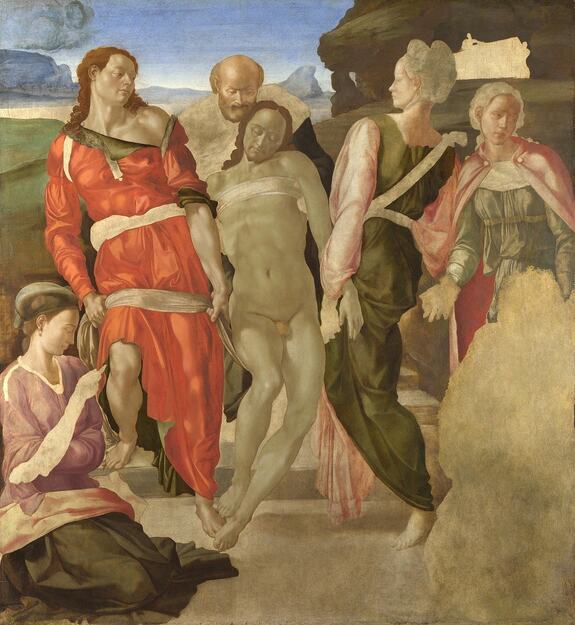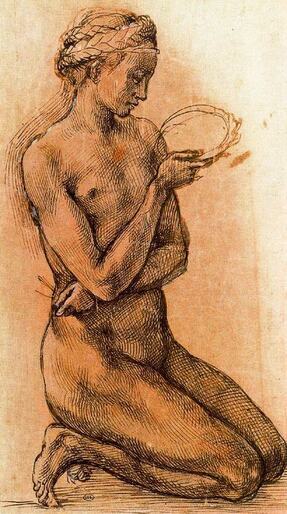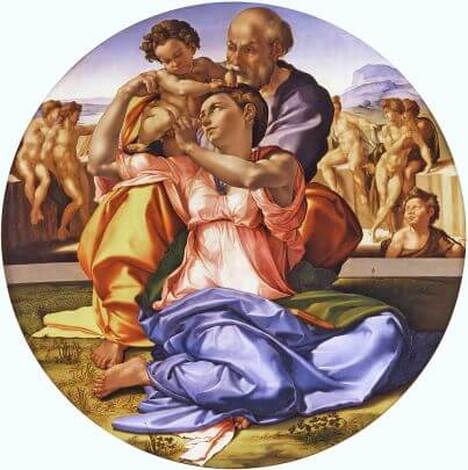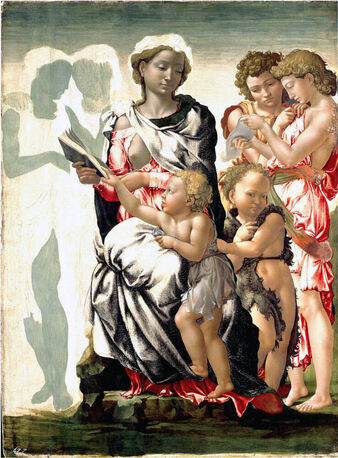|
Where? Room 20 of the National Gallery
When? Probably 1500-1501 Commissioned by? Possibly for the church of Sant'Agostino in Rome
What do you see? This unfinished painting shows how the lifeless body of Jesus is carried up some steps to be put in his tomb. The beautifully-painted body of Jesus has already been washed after the crucifixion as there is no sign of blood on his hands and feet and the crown of thorns has been removed. The tomb was owned by Joseph of Arimathea, who is the bearded man standing behind Jesus. Two broad linen bands support the body of Jesus. The person to the left of Jesus in the magnificent red-orange robe is Saint John, and the person on the right is probably Nicodemus.
Backstory: This painting provides a good look at how Michelangelo worked on a painting. For this painting, he first created a drawing and based on that he painted the different parts and colors one by one. Because this painting is unfinished, there has been quite some uncertainty and debate about this painting over the years.
There are different theories about when he painted this, for who, and whether it is a painting from Michelangelo or whether the painting or parts of it should be attributed to some of his students. But there is also uncertainty about who is who in the painting. For example, it is not completely clear who is Mary Magdalene and who is Mary Salome in the picture, and there is also debate whether the person directly to the right of Jesus is indeed Nicodemus (or maybe a woman instead). What is the entombment? The burial of Jesus is described in the four Gospels and is referred to in the letter of Paul to the Corinthians. The Gospels tell somewhat different stories on the burial of Jesus. In short, Joseph of Arimathea asked for the body of Jesus after the crucifixion to bury it in accordance with the Jewish law which stated that a body could not be left exposed during the night. According to the Gospel of John, he got help from Nicodemus. Mary Magdalene and the Virgin Mary were also present at the burial. The body of Jesus was washed, wrapped in linen, and spices were put on the linen. After that, the body of Jesus was put in a tomb cut out of rock and a big stone was rolled in front of the entrance. Why the entombment? While it is not entirely clear who commissioned this painting, the theme of the entombment may be a great one for an altarpiece. When people in a Catholic Mass kneel in front of the altar and look up, they would see the body of Christ. This view would remind them that the ritual bread that they eat and the wine that they drink during the Mass represents the body of Christ.
Who is Michelangelo? Michelangelo di Lodovico Buonarroti Simoni (1475-1564) was born in Caprese which is about 50 miles (or 80km) from Florence. However, he was raised from a young age in Florence. During his life, he kept going back and forth between Florence and Rome. He developed himself into one of the greatest artists of all time and was a great painter, sculptor, architect, and even a poet. Quite some work of Michelangelo has survived, but interestingly only three paintings have survived. Michelangelo is better known for his frescos and sculptures.
Fun fact: This is not the only work that Michelangelo did not finish. In fact, he was quite good at abandoning his works halfway. Another unfinished painting of him in the National Gallery (in Room 20) is The Virgin and Child with Saint John and Angels (also known as the Manchester Madonna). Yet another great example of his unfinished work is the series of unfinished sculptures in the Galleria Academica in Florence. There is only one completed painting by Michelangelo that survived, which is the Doni Tondo in the Uffizi Museum. Of course, he also finished various sculptures and frescos of which the most famous one is the ceiling of the Sistine Chapel in Rome. Other artists that were notorious for not finishing their paintings include Leonardo da Vinci and Parmigianino.
Written by Eelco Kappe
References:
0 Comments
Leave a Reply. |
Categories
All
|
- Home
- Blog
-
Museums
- Alte Pinakothek
- Art Institute of Chicago
- Baltimore Museum of Art
- Barber Institute of Fine Arts
- Bargello
- Barnes Foundation
- British Museum
- Church of Sant’Anastasia
- Cleveland Museum of Art
- Courtauld Institute of Art
- Detroit Institute of Arts
- Frans Hals Museum
- Galleria Borghese
- Gallerie dell'Accademia
- Getty Museum
- Guggenheim
- Hermitage Museum
- Kunsthistorisches Museum
- Kunstmuseum Basel
- Legion of Honor Museum
- Louvre
- Mauritshuis
- Metropolitan Museum of Art
- Musee d’Orsay
- Museum of Fine Arts in Boston
- Museum of Modern Art
- National Gallery in London
- National Gallery of Art
- National Museum in Poznań
- Norton Simon Museum
- Ny Carlsberg Glyptotek
- Palace of Versailles
- Palazzo Pitti
- Palazzo Vecchio
- Petit Palais
- Philadelphia Museum of Art
- Prado
- Pushkin Museum
- Ravenna Art Museum
- Rijksmuseum
- San Diego Museum of Art
- Santa Maria delle Grazie
- St. Peter's Basilica
- Städel Museum
- Statens Museum for Kunst
- Tate Britain
- Tate Modern
- Timken Museum of Art
- Uffizi
- Vatican Museums
- Wallace Collection
-
Artists
- Altdorfer
- Anguissola
- Berlin Painter
- Bosch
- Botticelli
- Boucher
- Bronzino
- Bruegel the Elder
- Brunelleschi
- Cabanel
- Caillebotte
- Canova
- Caravaggio
- Carpeaux
- Cezanne
- Cimabue
- David
- Degas
- Delacroix
- De Maria
- Donatello
- El Greco
- Fontana
- Fra Angelico
- Fragonard
- Gauguin
- Gentileschi
- Gericault
- Gonzalez-Torres
- Goya
- Hals
- Hogarth
- Hokusai
- Ingres
- Leonardo da Vinci
- Lippi, Filippo
- Longhi, Barbara
- Lorrain
- Makovsky
- Manet
- Massys
- Matisse
- Merian
- Michelangelo
- Mochi
- Modigliani
- Monet
- Panini
- Parmigianino
- Perugino
- Picasso
- Pisanello
- Raphael
- Rembrandt
- Renoir
- Reynolds
- Rivera
- Rodin
- Rubens
- Scultori
- Seurat
- Steen
- Tintoretto
- Titian
- Toulouse-Lautrec
- Turner
- Uccello
- Van der Weyden
- Van Dyck
- Van Eyck
- Van Gogh
- Van Hemessen
- Vasari
- Velazquez
- Vermeer
- Veronese
- Vigée Le Brun
-
Locations
- Books
- About Us




